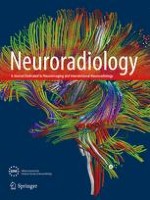01-09-2004 | Diagnostic Neuroradiology
Extracranial–intracranial arterial bypass surgery improves total brain blood supply in selected symptomatic patients with unilateral internal carotid artery occlusion and insufficient collateralization
Published in: Neuroradiology | Issue 9/2004
Login to get accessAbstract
It remains controversial whether extracranial–intracranial (EC–IC) arterial bypass surgery leads to a significant increase in brain blood supply, allowing the reversal of regional cerebral hypoperfusion in symptomatic patients with occlusive cerebrovascular disease and hemodynamic impairment. The aim of the present study was to determine the effects of EC–IC bypass surgery on cerebral brain-supplying blood volume flow (BVF; ml/min) from a purely hemodynamic point of view, using 2D cine phase-contrast MR imaging. Twenty-five patients with symptomatic, unilateral internal carotid artery (ICA) occlusion and hemodynamic compromise received EC–IC arterial bypass surgery. All patients underwent quantitative BVF measurements of brain-supplying arteries preoperatively and postoperatively, including the direct BVF measurement in the established EC–IC bypass after surgery. Preoperatively, total brain BVF was reduced in comparison to normal controls (595±89 vs 663±49 ml/min; [mean±SEM]; p=0.039). Mean BVF through the EC–IC bypass reached 84±32 ml/min (range: 14–177 ml/min), leading to a significant net increase in total BVF of 78±43 ml/min (range: 7–136 ml/min) when compared with BVF prior to surgery (p<0.001), with resulting postoperative BVF reaching values obtained in normal controls. EC–IC arterial bypass surgery increases total brain blood supply, allowing restoration of local perfusion in hemodynamically compromised brain tissue in patients with symptomatic ICA occlusion.





